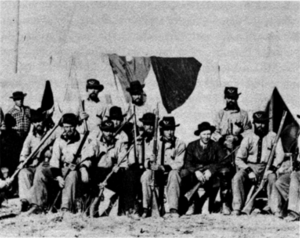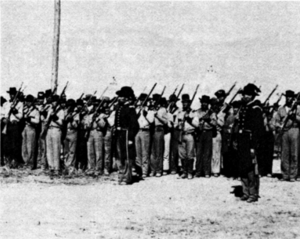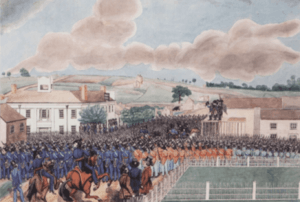Nauvoo Legion facts for kids
Quick facts for kids Nauvoo Legion |
|
|---|---|

General Joseph Smith commanding the Nauvoo Legion infantrymen in formation between 1839 and 1844 in Nauvoo, Illinois, with the Nauvoo Temple on a hill in the background
|
|
| Country | |
| Allegiance | Joseph Smith
Church of Jesus Christ of Latter Day Saints |
| Branch | Illinois State Militia (1840–1845)
Mormon Battalion (United States Army) (1846–1847) Deseret Militia (1847–1852) Utah Territorial Militia (1852–1887) |
| Type | Militia |
| Role | Protect Mormon settlers from domestic and foreign enemies |
| Size | Illinois State Militia (2,500)
Mormon Battalion – five companies (534–559) Deseret Militia ? Utah Territorial Militia ? |
| Engagements | Illinois Mormon War (1844–1846)
Utah Mormon War (1857–1858)
|
| Disbanded | 1887 |
| Commanders | |
| Notable commanders |
Lieutenant General Joseph Smith
General John C. Bennett Utah Territorial Military Commander Robert T. Burton Utah Territorial Governor Stephen S. Harding Dimick B. Huntington |
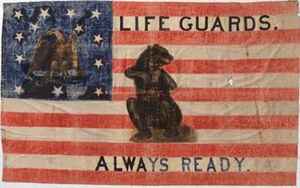
The Nauvoo Legion was a special military group in the city of Nauvoo, Illinois, in the United States. It was created by the state government. As problems grew with nearby towns, its main job became protecting Nauvoo and other areas where Latter Day Saints lived.
The state of Illinois gave Nauvoo a special city law that allowed the Nauvoo Legion to be very independent. Even so, it was still part of the Illinois State Militia and had to follow the Governor of Illinois. Joseph Smith, who started the Latter Day Saint movement and was also the mayor of Nauvoo, led the Legion. It quickly became a strong military force.
Before this, in 1834, Joseph Smith led a group of Latter Day Saints called Zion's Camp. They traveled from Kirtland, Ohio, to Clay County, Missouri. They wanted to get back land that non-Mormon settlers had taken from them. Smith created the first Mormon militia group, the "Armies of Israel," to protect his people.
In 1844, a newspaper in Nauvoo printed articles that criticized Joseph Smith and his church. Smith ordered the newspaper to be burned. Because of this, Joseph Smith was ordered to Carthage Jail on charges of treason. While there, Smith was killed by a mob. Soon after, the special law for Nauvoo was canceled, and the Nauvoo Legion was no longer an official part of the Illinois militia.
After the Nauvoo law was canceled, members of the Nauvoo Legion continued to follow Brigham Young. He was the new leader of the largest group of Latter-day Saints, The Church of Jesus Christ of Latter-day Saints (LDS Church). Young led the Latter-day Saints to what later became the Territory of Utah. In Utah, the Deseret Militia and Utah Territorial Militia used the name Nauvoo Legion. The Nauvoo Legion was officially stopped in 1887. In 1894, the former Utah Territorial Militia started again and was named the Utah National Guard.
Contents
Forming the Nauvoo Legion
In 1839, Joseph Smith moved his followers from Missouri to Commerce, Illinois, because of problems there. He renamed the town Nauvoo. In 1840, politicians in Illinois agreed to a special law for Nauvoo. This law gave Smith and the city of Nauvoo many powers. One of these powers was to create an "independent military group." This group was a militia, much like the Illinois State Militia, and it was called the "Nauvoo Legion."
At its strongest, the Nauvoo Legion had at least 2,500 soldiers. To compare, the entire United States Army had about 8,500 soldiers in 1845. The Legion was set up with two groups of foot soldiers (called cohorts) and one group of cavalry (soldiers on horseback). They also had a few small cannons.
The Legion had many high-ranking officers compared to regular soldiers. This was likely done to give some city members a higher social standing.


Who Was in Charge of the Legion?
The law that created the Nauvoo Legion made it an independent militia. However, it could still be used by the state governor or the President of the United States. It could also be used by the mayor of Nauvoo. Joseph Smith was the second mayor of Nauvoo. The Nauvoo court martial also made him the highest-ranking officer of the Legion, a Lieutenant General. This rank is higher than Major General, which was usually the top rank in other militias at the time. One reason for this higher rank was to prevent Smith from being judged by officers of lower rank.
Nauvoo Under Martial Law
In June 1844, Joseph Smith declared martial law in Nauvoo. This meant that military rule was put in place because of problems in the city. He first used the Nauvoo Legion to defend the city. However, he later told the Legion not to take any action. This happened when the Illinois governor ordered the arrest of Joseph Smith and his brother for breaking state laws.
The Death of Joseph Smith
Joseph Smith and his brother Hyrum went to the Carthage jail. Governor Thomas Ford and the local militia, the Carthage Greys, promised to protect them. But on June 27, 1844, a large mob surrounded the jail. The Carthage Greys were greatly outnumbered and did not stop the mob from killing Joseph and Hyrum Smith.
The Legion After Smith's Death
The Nauvoo Legion continued even after Joseph Smith, its leader, was killed. Brigham Young became the new church president in August 1844 and took command. Young had not been active in the Legion before this because he was in England on a mission. He returned to Nauvoo after hearing about Smith's death.
Instead of using the Legion to fight the growing violence from mobs, Young told the thousands of Nauvoo citizens to move peacefully west. This area was not yet part of the United States. They eventually founded the territory of Utah. Nauvoo was officially left empty. The last citizens left by September 17, 1846, as Illinois and Missouri militias and mobs attacked and burned Nauvoo.
After the Nauvoo law was canceled in 1844–1845, the Nauvoo Legion was no longer an official state militia. Its members returned most of their government-issued weapons. Even without official status, parts of the Legion helped protect the groups traveling west with handcarts and wagons. Hosea Stout reorganized them on September 22, 1846, on the other side of the Mississippi River in Iowa. There, the citizens of Nauvoo were safe from attacks while they waited for winter to end before continuing their journey.
There are also reports in people's diaries about gunfights between Legion members and mobs during the Nauvoo period. Some Legion members also helped rescue Joseph Smith when the state militia unlawfully arrested him.
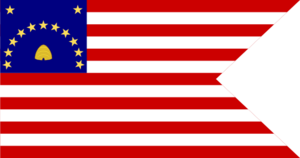
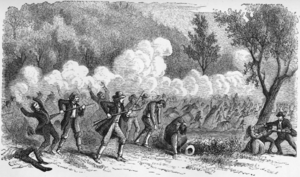
The Legion in Utah
Mormon Battalion in the Mexican–American War
Soon after the Mormons arrived in Iowa in 1846, some Legion members volunteered to join the Mormon Battalion. This was a group of 500 men who served the U.S. government. They went on a military trip to Mexican California during the Mexican–American War.
Deseret Territorial Militia
In 1847, Mormon leader Brigham Young restarted the Nauvoo Legion. It became a full paramilitary force. It was organized into smaller groups for each county in Utah. This new group was called the Deseret Territorial Militia.
Conflicts with Native Americans
The Nauvoo Legion had conflicts with Native Americans in Utah County. These included attacks at Battle Creek and the Battle at Fort Utah in 1849. These events led to the 1853–1854 Walker War. This war was between the Nauvoo Legion and Indians led by Chief Walkara ("Walker").
The Utah War
The Nauvoo Legion was called into action again during the Utah War from 1857 to 1858. This was a conflict against Federal troops entering Utah. The Legion used tactics like destroying supplies to avoid direct fighting. However, local commanders of the Iron County, Utah Territorial Militia, in a state of fear, carried out the Mountain Meadows Massacre in September 1857. This attack was against a group of wagon trains traveling from Arkansas to California. At this time, Daniel H. Wells was the main military commander of the militia.
After this conflict, the Federal government appointed Utah's territorial governor. The Nauvoo Legion was allowed to continue under the governor's command. However, it was not as cooperative with federal authorities as they wished.
The American Civil War
During the American Civil War, federal troops either left Utah or joined the rebellion. The Federal government asked Brigham Young for help. With his permission, two groups from the reorganized Nauvoo Legion were used by the United States. Their job was to protect western mail and telegraph lines from Native American attacks in what is now Utah and Wyoming. They did not see any direct fighting. The Legion did not take part in the main battles of the Civil War. The Legion's involvement ended in 1862.
Utah's Black Hawk War
The last time the Legion was used was in Utah's Black Hawk War from 1865 to 1872. More than 2,500 soldiers were sent to fight Native Americans led by Antonga Black Hawk. (This Antonga Black Hawk was a Ute chief and was not connected to the Illinois Sauk chief Black Hawk from the 1830s.) In 1870, Utah Territorial Governor J. Wilson Shaffer ordered the Legion to stop its activities unless he gave permission. Federal troops were sent to make sure Shaffer's order was followed.
Becoming the Utah National Guard
The Nauvoo Legion never gathered again after 1870. In 1887, a law called the Edmunds-Tucker Act permanently disbanded it. In 1894, as Utah was getting ready to become a state, the Utah National Guard was formed. This new group became Utah's official state militia.
Weapons and Gear
The Nauvoo Legion in Illinois used weapons from the Federal government. The most common gun given to these soldiers was the Model 1816 Musket. This was a flintlock musket, which was an American copy of a French musket. The Harper's Ferry Model 1803 Rifle was also given out, but in smaller numbers. Soldiers also used their own personal weapons.
A small artillery piece, an 1841 12-pound mountain howitzer, was given to the territorial militia. It arrived in Salt Lake in 1852. The Legion in Nauvoo also bought a carronade, which is a type of ship cannon. This cannon was carried to Salt Lake by the early settlers and sometimes used as a speaker's stand. It was nicknamed the "Old Sow" and is now on display at the Church History Museum in Salt Lake City.
When the Mormon Battalion joined the army in July 1846, about 450 Model 1816 muskets were given to the foot soldiers. Five 1803 Harpers Ferry rifles were given to the hunters in one company. After the men finished their service in 1847, many stopped to work at Sutter's Fort. Six of them built a mill where gold was later discovered. Many of them found gold. When they continued their journey home, they bought two cannons from Sutter. These cannons were thought to be Russian or French.
In 2001, three Spanish cannons were found in a storage facility in Salt Lake City. One bronze 4-pound cannon had the crest of King Carlos III of Spain. A 6-pound iron cannon, likely the other battalion cannon, and a smaller 2-pound cannon were also there. All three Spanish cannons were mounted on carriages similar to the mountain howitzer carriage. Today, the mountain howitzer is at the Fort Douglas museum in Salt Lake City. The 4-pound Spanish bronze cannon is at the Mormon Battalion Visitor Center in San Diego, California.
See also
 In Spanish: Legión Nauvoo para niños
In Spanish: Legión Nauvoo para niños



